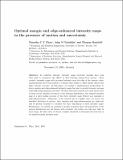| dc.contributor.author | Chan, Timothy C. Y. | |
| dc.contributor.author | Tsitsiklis, John N. | |
| dc.contributor.author | Bortfeld, Thomas | |
| dc.date.accessioned | 2012-08-01T19:54:24Z | |
| dc.date.available | 2012-08-01T19:54:24Z | |
| dc.date.issued | 2009-12 | |
| dc.date.submitted | 2009-11 | |
| dc.identifier.issn | 0031-9155 | |
| dc.identifier.issn | 1361-6560 | |
| dc.identifier.uri | http://hdl.handle.net/1721.1/71949 | |
| dc.description.abstract | In radiation therapy, intensity maps involving margins have long been used to counteract the effects of dose blurring arising from motion. More recently, intensity maps with increased intensity near the edge of the tumour (edge enhancements) have been studied to evaluate their ability to offset similar effects that affect tumour coverage. In this paper, we present a mathematical methodology to derive margin and edge-enhanced intensity maps that aim to provide tumour coverage while delivering minimum total dose. We show that if the tumour is at most about twice as large as the standard deviation of the blurring distribution, the optimal intensity map is a pure scaling increase of the static intensity map without any margins or edge enhancements. Otherwise, if the tumour size is roughly twice (or more) the standard deviation of motion, then margins and edge enhancements are preferred, and we present formulae to calculate the exact dimensions of these intensity maps. Furthermore, we extend our analysis to include scenarios where the parameters of the motion distribution are not known with certainty, but rather can take any value in some range. In these cases, we derive a similar threshold to determine the structure of an optimal margin intensity map. | en_US |
| dc.description.sponsorship | National Cancer Institute (U.S.) (grant R01-CA103904) | en_US |
| dc.description.sponsorship | National Cancer Institute (U.S.) (grant R01-CA118200) | en_US |
| dc.description.sponsorship | Natural Sciences and Engineering Research Council of Canada (NSERC) | en_US |
| dc.description.sponsorship | Siemens Aktiengesellschaft | en_US |
| dc.description.sponsorship | Massachusetts Institute of Technology. Hugh Hampton Young Memorial Fund fellowship | en_US |
| dc.language.iso | en_US | |
| dc.publisher | IOP Publishing | en_US |
| dc.relation.isversionof | http://dx.doi.org/10.1088/0031-9155/55/2/012 | en_US |
| dc.rights | Creative Commons Attribution-Noncommercial-Share Alike 3.0 | en_US |
| dc.rights.uri | http://creativecommons.org/licenses/by-nc-sa/3.0/ | en_US |
| dc.source | Tsitsiklis via Amy Stout | en_US |
| dc.title | Optimal margin and edge-enhanced intensity maps in the presence of motion and uncertainty | en_US |
| dc.type | Article | en_US |
| dc.identifier.citation | Chan, Timothy C Y, John N Tsitsiklis, and Thomas Bortfeld. “Optimal margin and edge-enhanced intensity maps in the presence of motion and uncertainty.” Physics in Medicine and Biology 55.2 (2010): 515-533. | en_US |
| dc.contributor.department | Massachusetts Institute of Technology. Department of Electrical Engineering and Computer Science | en_US |
| dc.contributor.department | Massachusetts Institute of Technology. Laboratory for Information and Decision Systems | en_US |
| dc.contributor.approver | Tsitsiklis, John N. | |
| dc.contributor.mitauthor | Tsitsiklis, John N. | |
| dc.relation.journal | Physics in Medicine and Biology | en_US |
| dc.eprint.version | Author's final manuscript | en_US |
| dc.type.uri | http://purl.org/eprint/type/JournalArticle | en_US |
| eprint.status | http://purl.org/eprint/status/PeerReviewed | en_US |
| dspace.orderedauthors | Chan, Timothy C Y; Tsitsiklis, John N; Bortfeld, Thomas | en |
| dc.identifier.orcid | https://orcid.org/0000-0003-2658-8239 | |
| mit.license | OPEN_ACCESS_POLICY | en_US |
| mit.metadata.status | Complete | |
